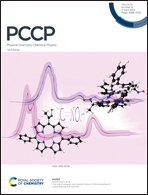A photoelectron spectroscopic investigation of aspirin, paracetamol and ibuprofen in the gas phase†
Abstract
We have investigated the electronic structure of isolated molecules of paracetamol, aspirin and ibuprofen using computational methods and benchmarked the results against valence and core photoelectron spectra. Paracetamol, aspirin and ibuprofen exist as multiple conformers, and we have calculated the free energies and populations of the lowest energy conformers. We find generally good agreement with previous experimental and theoretical structural results. The valence band spectrum of gas phase aspirin has not been reported previously, and we report it and assign the features based on calculations. The effect of acetylation on the frontier orbitals of the parent molecule, salicylic acid, is to increase the ionization potential of the highest occupied molecular orbital (HOMO), and to exchange the energetic ordering of the following two orbitals. The acetyl π bond contributes to the next orbital, which is hybridised with ring π orbitals. The core level spectra of all three molecules are reported and compared with calculations and with the spectra of parent molecules (salicylic acid for aspirin, 4-aminophenol for paracetamol). Observed core ionization energies are in agreement with theory. Although all compounds share a benzene ring, and they also have a number of other chromophores in common, the spectroscopic data indicate chemical diversity, suggesting that their modes of bonding under physiological conditions are likely to be diverse.



 Please wait while we load your content...
Please wait while we load your content...